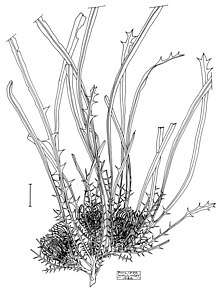Banksia subpinnatifida
Banksia subpinnatifida is a species of bushy shrub that is endemic to the southwest of Western Australia. It has more or less linear, pinnatipartite leaves with sharply-pointed teeth on the sides, golden yellow flowers in heads of about sixty, and glabrous, elliptical follicles.
| Banksia subpinnatifida | |
|---|---|
 | |
| Illustration by Philippa Nikulinsky | |
| Scientific classification | |
| Kingdom: | Plantae |
| Clade: | Tracheophytes |
| Clade: | Angiosperms |
| Clade: | Eudicots |
| Order: | Proteales |
| Family: | Proteaceae |
| Genus: | Banksia |
| Subgenus: | Banksia subg. Banksia |
| Series: | Banksia ser. Dryandra |
| Species: | B. subpinnatifida |
| Binomial name | |
| Banksia subpinnatifida | |
| Synonyms[1] | |
|
Dryandra subpinnatifida C.A.Gardner | |
Description
Banksia subpinnatifida is a bushy shrub that typically grows to a height of 1.6 m (5 ft 3 in) but does not form a lignotuber. It has more or less linear leaves that are 50–350 mm (2.0–13.8 in) long, 2–16 mm (0.079–0.630 in) wide on a petiole up to 20 mm (0.79 in) long. There are up to fifteen widely-spaced teeth in the lower half of the leaf. The flowers are golden yellow and arranged in heads of between sixty and seventy, the heads often crowded on short side branches. There are linear to lance-shaped involucral bracts 11–20 mm (0.43–0.79 in) long at the base of the head. The perianth is woolly-hairy, 26–28 mm (1.0–1.1 in) long and the pistil 34–41 mm (1.3–1.6 in) long, gently curved and glabrous. Flowering occurs from September to October and the fruit is a glabrous, elliptical follicle 9–13 mm (0.35–0.51 in) long.[2][3]
Taxonomy
This species was first formally described in 1964 by Charles Austin Gardner who gave it the name Dryandra subpinnatifida and published the description in the Journal of the Royal Society of Western Australia from specimens collected by Fred Lullfitz.[4][5]
In 1996, Alex George describe two varieties of Dryandra subpinnatifida in the journal Nuytsia:
- Dryandra subpinnatifida subsp. inerbis that has about sixty flowers in each head and bracts up to 20 mm (0.79 in) long;
- Dryandra subpinnatifida subsp. subpinnatifida that has between forty and fifty flowers in each head and bracts to 12 mm (0.47 in) long.[6]
In 2007, Austin Mast and Kevin Thiele transferred all the dryandras to the genus Banksia and this species became Banksia subpinnatifida and the varieties var. inerbis and subpinnatifida respectively.[7][8][9][10]
Distribution and habitat
Banksia subpinnatifida is found between Pingelly and Tambellup. Variety inerbis occurs between Boddington and Broomehill, and var. subpinnatifida grows in thick scrub between Pingelly and Narrogin.
Conservation status
Banksia subpinnatifida is classified as "not threatened" by the Western Australian Government Department of Parks and Wildlife but var. inerbis is listed as "Priority Three" [11] meaning that it is poorly known and known from only a few locations but is not under imminent threat and var. subpinnatifida as "Priority Two"[12] meaning that it is poorly known and from only one or a few locations.[13]
References
- "Banksia subpinnatifida". Australian Plant Census. Retrieved 6 June 2020.
- George, Alex S. (1999). Flora of Australia (PDF). 17B. Canberra: Australian Biological Resources Study, Canberra. pp. 278–280. Retrieved 6 June 2020.
- "Banksia subpinnatifida". FloraBase. Western Australian Government Department of Parks and Wildlife.
- "Dryandra subpinnatifida". APNI. Retrieved 6 June 2020.
- Gardner, Charles A. (1964). "Contributiones Florae Australiae Occidentalis XIII". Journal of the Royal Society of Western Australia. 47 (2): 58–59. Retrieved 6 June 2020.
- George, Alex (1996). "New taxa and a new infrageneric classification in Dryandra R.Br. (Proteaceae : Grevilleoideae)". Nuytsia. 10 (3): 340–341. Retrieved 6 June 2020.
- "Banksia subpinnatifida". APNI. Retrieved 6 June 2020.
- Mast, Austin R.; Thiele, Kevin (2013). "The transfer of Dryandra R.Br. to Banksia L.f. (Proteaceae)". Australian Systematic Botany. 20 (1): 63–71. doi:10.1071/SB06016.
- "Banksia subpinnatifida var. inerbis". Australian Plant Census. Retrieved 6 June 2020.
- "Banksia subpinnatifida var. subpinnatifida". Australian Plant Census. Retrieved 6 June 2020.
- "Banksia subpinnatifida var. inerbis". FloraBase. Western Australian Government Department of Parks and Wildlife.
- "Banksia subpinnatifida var. subpinnatifida". FloraBase. Western Australian Government Department of Parks and Wildlife.
- "Conservation codes for Western Australian Flora and Fauna" (PDF). Government of Western Australia Department of Parks and Wildlife. Retrieved 6 June 2020.